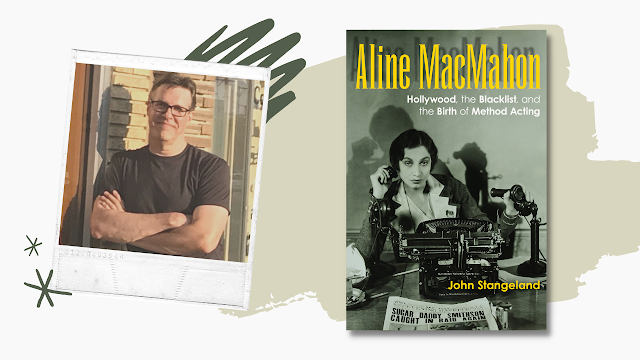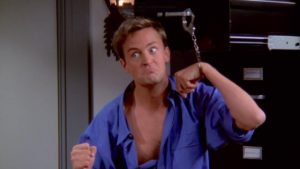I’m thrilled to be joined by writer and biographer John Stangeland. We chatted over a decade ago about his Warren William biography (review here and interview here). Now he is back with an excellent new biography on the much-beloved character actress Aline MacMahon, out now from the University Press of Kentucky. I was honored to have contributed this blurb for the book’s publication:
“Stangeland shines a much needed spotlight on one of the great actresses of stage and screen whose talent and versatility was admired by many. … Absorbing and highly readable, this biography will rescue MacMahon from obscurity and give her the recognition she so greatly deserves.”— Raquel Stecher, film historian and critic
Now onto the interview!
Raquel Stecher: Congratulations on your new book! In 2010 you published your book Warren William: Magnificent Scoundrel of Pre-Code Hollywood. How did you chose Aline MacMahon as the subject of your next biography?
John Stangeland: I had been aware of Aline for quite a while. I probably saw Five Star Final—her first film—when I was about 12 or 13. I started looking closer at her while I was writing the Warren William book, since they share two films together. That was when I first noticed how different her acting style was in comparison to the other actors of the period. I mean very obviously different—almost as if she was pulled from the modern era and placed among that earlier style of acting. That intrigued me, so I started digging into her story.
Raquel: Aline MacMahon was best known for her work as a character actress but many don’t realize that she was one of the original Method actors. Can you tell us a bit about her approach to her craft?
John: Well, this is one of the things that made this project a book instead of an article. I discovered that in America the Method goes back much further than most people know, and that Aline is not just a devotee, but is the first popular actor to use the technique on both stage and screen here in the West. Aline’s initial training dates all the way back to 1923—nearly 30 years before Marlon Brando made the Method a household word. This explained to me why in 1931 she looked so naturalistic in comparison to everyone else on screen. She was applying the method technique before anyone else: using emotional recall, creating a character history, dredging internal motivation. Her most succinct description about the effect of the Method on her technique was that the lessons “taught me how to concentrate.”
 |
| Aline as a Marseille prostitute in the Broadway production of Maya (1928). Image courtesy of John Stangeland |
Raquel: In your book you discuss Aline MacMahon’s rich inner life, her social conscience and activism. How did her politics affect her career?
John: Aline’s maternal aunt Sophie Irene Loeb was a well-known activist and writer in New York City just after the turn of the century. Before Aline was even a teenager, Sophie would take her on inspection tours of the NYC slums so she could experience the dark side of poverty and immigrant life. From that seed Aline became a progressive liberal who believed in charity and government programs for the poor. Eventually that developed into a benign interest in Communism and issues of social justice. Unfortunately, the late 1940s and ’50s was a dangerous time to be a Communist, or even Communist-curious. When the hysteria of McCarthyism spread out across America, Aline found herself blacklisted as a Communist (although she never joined the party) and largely unable to work on TV, films or stage for the greater part of a decade. Simultaneously, both she and her husband spent fifteen years under covert surveillance by the FBI. Fortunately Aline was philosophical about the situation, but as her exile lengthened she finally hit a wall. “Some dimming of the luck is to be expected,” she said. “But by God, have we been condemned to purgatory forever? Life is for laughing, too….”
Raquel: In your biography you said that even though Aline McMahon wasn’t a big star it didn’t mean that her life story wasn’t interesting. What are some other facts that readers might not be aware of that may pique their interest in learning more about her?
John: There are quite a few doors into Aline’s story. In the early 1920’s she became a member of the Neighborhood Playhouse, where she developed close friendships within NYC’s then-underground gay and trans subculture. She had a fascinating love affair of equals; in 1928 she married Clarence Stein, a New York based architect and city planner. Clarence, well-known and highly respected in his field (there are more than a few books about him), supported all of her endeavors, including liberal politics, and her career, which took her away from New York for six months a year. They both loved exotic travel, and during the era of the steamship they went to places rarely visited by polite Americans, including India, Siam (Thailand), Bali, Iran, and, in 1937 an around-the-world cruise where they lived for three months in China. The Steins also counted as their friends a who’s-who of some of the 20th Century’s great figures in the arts: Diego Rivera, Isamu Noguchi, Eugene O’Neill, Moss Hart, George Kaufman, E.E. Cummings, Thomas Wolfe, Aline Bernstein and many others. The Steins also endured some Dickensian setbacks which always reminded them how fortunate they really were. They never took their success for granted and always tried to help people who did not have as much as they did.
 |
| Aline shooting a scene from Kind Lady (1935) with Basil Rathbone. Image courtesy of John Stangeland |
Raquel: What kind of research did you do for the book? Did you encounter anything surprising or revelatory that changed the course of your writing?
John: The research went from Los Angeles to New York and a bunch of places in between! It is always fun to visit the Warner Bros. archives in L.A., and the Shubert archives in New York—but the BIG revelation came when I visited Cornell University in Ithaca, New York. Aline donated some of her papers there, and her husband’s papers went there after he died in 1975. Looking through her papers was wonderful, but limited. Many of her other effects were in New York and the archive there had some nice things but nothing noteworthy. However, when I got to the Clarence Stein papers I was shocked to find thousands of letters between Aline and Clarence, beginning the DAY she first left for Hollywood (January 1st, 1931) and stretching for decades. THAT was exciting, and a little daunting. It took months to go through those letters.
Raquel: Can you talk a bit about what those letters were like and what they revealed about her career?
John: On one hand they were a daily diary of her time in Hollywood, with unfiltered thoughts about her directors and co-stars. (Warren William? “A ham.” Edward G. Robinson? “He’s getting a big head.” Paul Muni? “So warm and nice.” Michael Curtiz? “A violent fool who never made a good picture.” Mervyn LeRoy? “My dear Svengali.”) More importantly, the letters give real insight into her character. Even in her private moments she was very thoughtful about social issues and usually worried about others more than herself. She didn’t dwell on bad things, and even in the worst of times—her husband’s mental breakdowns and her own blacklisting—she maintained a sense of perspective. The letters reveal a remarkably intelligent woman—she was one of the few college educated women of the old Hollywood—and a compassionate one as well.
Raquel: Do you have a favorite Aline MacMahon performance?
John: My favorite is probably Heat Lightning (1934), which was also her first starring role. For me it is a hidden gem of the pre-Code and a scorching proto-Noir. On the comedy side, she’s hilarious as Trixie in Gold Diggers of 1933 and as May Daniels in Once in a Lifetime (1932), a role that she originated for the Broadway production. Lifetime is very rarely shown—I don’t remember ever seeing it on TCM —but worth seeking out if you can find a better print than they have on YouTube!
 |
| Aline during the readings of the Sean O’Casey memoir Pictures in the Hallway (1956). Image courtesy of John Stangeland |
Raquel: MacMahon worked as an actress for 55 years. What do you think drove her to work for as long as she did despite the difficulties she faced with the studio system and the blacklist?
John: Aline didn’t just love acting, she once said “I must act to live.” When she had a great role and was operating at the top edge of her capabilities, she felt completely fulfilled. It did not equate to money or fame—one of her favorite things she did was a series staged readings of the memoirs of Sean O’Casey, for which she was paid something like $5 a performance. If it was challenging and of high quality it made her feel alive. I think she was always chasing that next opportunity to feel satisfied in her art—to work with a Eugene O’Neill, or to be in the cast of Hamlet at Kronborg Castle in Denmark, which she did in 1948.
Raquel: What do you hope readers will take away from your book?
John: Of course I want the reader to be entertained, and hopefully learn something new about the movies, or about creative character. But ultimately I want people to get to know Aline MacMahon as more than just someone who entertains them on screen. I have developed a real soft spot for her; so intelligent, talented, thoughtful, curious, loyal and compassionate. A wonderful person to know.
Raquel: What are you working on next? Where can readers find you online?
John: The next project looks like it will be a novel. It begins in 1912 when a young man arrives in Chicago from Kansas looking to join the film industry and finds work at Essanay studios. From there we follow his path through the history of Hollywood into the early 1980s, during which he will encounter recurring characters in Charlie Chaplin, Wallace Beery, Karl Brown, George Spoor, Sam Zarkoff and others. It’s early in the planning stages, but will be a bildungsroman combined with a peculiar history of the film industry.
I’m not super involved on social media, but on instagram you will find me at: #studioerahollywood and (for you comic book fans out there) #atlascomicschi. On Facebook the page is Warren William: Magnificent Scoundrel of Pre-Code Hollywood, which doubles as an Aline MacMahon / old Hollywood page.
—————————————————————-

Aline MacMahon
Hollywood, the Blacklist, and the Birth of Method Acting
by John Stangeland
University Press of Kentucky
Hardcover ISBN: 9780813196060
416 pages
November 2022
Amazon — Barnes and Noble — Powell’s



